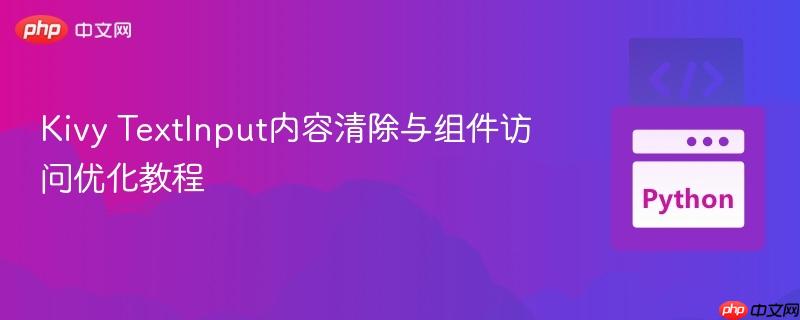
本教程旨在解决kivy应用中清除textinput组件内容时常见的错误,并提供更优的组件访问实践。文章将详细阐述如何将错误的`.txt`属性更正为正确的`.text`属性来清除输入框内容,并推荐使用`self.ids`机制替代`objectproperty`来访问kv文件中定义的组件,从而简化代码、提高可读性和维护性,最终帮助开发者构建更健壮的kivy应用程序。
在Kivy应用开发中,清除TextInput组件的内容是一个常见的需求,例如在用户提交表单或输入错误后重置输入框。然而,新手开发者可能会遇到无法成功清除内容的问题。这通常源于对TextInput组件属性的误用以及组件访问方式不够优化。
Kivy的TextInput组件用于接收用户输入,其当前文本内容存储在text属性中。一个常见的错误是将text属性误写为txt。当尝试通过self.createusername.txt = ""来清除输入框内容时,Kivy会因为找不到txt属性而无法执行操作,导致输入框内容保持不变。
错误示例(Python代码片段):
class CreateWindow(Screen):
createusername = ObjectProperty(None)
createpassword = ObjectProperty(None)
def resetType(self):
# 错误:应使用 .text 而非 .txt
self.createusername.txt = ""
self.createpassword.txt = ""
print("Working")在上述代码中,self.createusername.txt = ""试图修改一个不存在的属性,因此不会有任何效果。尽管print("Working")会正常执行,但输入框的内容并不会被清除。
解决方案:使用正确的text属性
要正确清除TextInput组件的内容,必须使用其标准的text属性。
class CreateWindow(Screen):
# ... 其他代码 ...
def resetType(self):
# 正确:使用 .text 属性
self.createusername.text = ""
self.createpassword.text = ""
print("Working")将self.createusername.txt和self.createpassword.txt更正为self.createusername.text和self.createpassword.text后,输入框的内容将能被成功清空。
除了属性名称的错误,原始代码中通过ObjectProperty来链接Python类和KV文件中定义的组件也是一种可优化的方式。Kivy提供了一个更简洁、更直接的机制来访问KV文件中带有id的组件,即self.ids字典。
原ObjectProperty方式的局限性:
在原始代码中,CreateWindow类通过声明ObjectProperty来引用KV文件中的TextInput:
class CreateWindow(Screen):
createusername = ObjectProperty(None) # 需要手动声明
createpassword = ObjectProperty(None) # 需要手动声明
# ...并在KV文件中进行绑定:
<CreateWindow>:
name: "Create"
createusername: createusername # 手动绑定
createpassword: createpassword # 手动绑定
# ...这种方式增加了代码的冗余,每当需要在Python代码中访问KV文件中定义的新组件时,都需要在Python类中声明对应的ObjectProperty,并在KV文件中进行绑定。
推荐方案:使用self.ids
Kivy会自动将KV文件中所有带有id的组件收集到其父Widget实例的ids字典中。这意味着,如果一个TextInput在KV文件中定义了id: createusername,那么在对应的Python类实例中,可以直接通过self.ids.createusername来访问这个组件。
使用self.ids重构CreateWindow类(Python代码片段):
class CreateWindow(Screen):
def createAccountButton(self):
# 直接通过 self.ids 访问组件
createdusername = str(self.ids.createusername.text)
createdpassword = str(self.ids.createpassword.text)
with open("database.txt", "a") as database:
database.write(createdusername + "," + createdpassword + '\n')
print("In file now")
database.close()
self.resetType()
def resetType(self):
# 通过 self.ids 访问并清除内容
self.ids.createusername.text = ""
self.ids.createpassword.text = ""
print("Working")对应的KV文件修改(移除ObjectProperty绑定):
<CreateWindow>:
name: "Create"
# 无需再声明 createusername: createusername 和 createpassword: createpassword
FloatLayout:
Button:
text:"Login"
size_hint: 0.5, 0.1
pos_hint: {"x":0.25, "y":0.3}
on_press: root.createAccountButton()
on_press: root.resetType() # 注意这里应调用 resetType() 方法
on_release:
app.root.current = "login"
TextInput:
id: createpassword # id 保持不变
size_hint: 0.25, 0.1
pos_hint: {"x":0.5, "y":0.5}
TextInput:
id: createusername # id 保持不变
size_hint: 0.25, 0.1
pos_hint: {"x":0.5, "y":0.6}
# ... 其他 Label 组件 ...注意: 在KV文件中调用方法时,如果方法不接受参数,应该使用 root.resetType() 而不是 root.resetType。
self.ids的优势:
结合上述两点优化,以下是经过重构的CreateWindow类及其对应的KV文件片段,展示了如何正确且高效地清除TextInput内容并访问组件。
import kivy
from kivy.app import App
from kivy.uix.widget import Widget
from kivy.uix.floatlayout import FloatLayout
from kivy.properties import ObjectProperty
from kivy.uix.screenmanager import ScreenManager, Screen
from kivy.lang import Builder
# LoginWindow 和 RealWindow 保持不变,此处省略
class CreateWindow(Screen):
def createAccountButton(self):
# 通过 self.ids 获取 TextInput 的文本内容
createdusername = str(self.ids.createusername.text)
createdpassword = str(self.ids.createpassword.text)
# 模拟保存数据到文件
with open("database.txt", "a") as database:
database.write(createdusername + "," + createdpassword + '\n')
print(f"Account created: {createdusername}")
self.resetType() # 调用重置方法
def resetType(self):
# 通过 self.ids 访问 TextInput 并清除其内容
self.ids.createusername.text = ""
self.ids.createpassword.text = ""
print("Input fields cleared.")
class WindowManager(ScreenManager):
pass
kv = Builder.load_file("login.kv")
class TestApp(App):
def build(self):
return kv
if __name__ == "__main__":
TestApp().run()KV文件 (login.kv):
WindowManager:
#: import NoTransition kivy.uix.screenmanager.NoTransition
transition: NoTransition()
LoginWindow:
CreateWindow:
RealWindow:
<LoginWindow>:
name: "login"
# 对于 LoginWindow,如果也需要清除内容,建议同样采用 self.ids 方式
# username: username # 移除此行
# password: password # 移除此行
FloatLayout:
Button:
text:"Log In"
size_hint: 0.5, 0.1
pos_hint: {"x":0.25, "y":0.3}
on_press: root.btn()
Button:
text:"Create Account"
size_hint: 0.3, 0.05
pos_hint: {"x":0.36, "y":0.20}
on_release:
app.root.current = "Create"
TextInput:
id: password # 保留 id
size_hint: 0.25, 0.1
pos_hint: {"x":0.5, "y":0.5}
TextInput:
id:username # 保留 id
size_hint: 0.25, 0.1
pos_hint: {"x":0.5, "y":0.6}
Label:
font_size: '40'
text:"Log In"
size_hint: 0.5, 0.5
pos_hint: {"x":0.25, "y":0.6}
Label:
font_size: '25'
text:"Username:"
size_hint: 0.5, 0.1
pos_hint:{"x":0.1,"y":0.6}
Label:
font_size: '25'
text:"Password:"
size_hint: 0.5, 0.1
pos_hint:{"x":0.1,"y":0.5}
<CreateWindow>:
name: "Create"
# 移除 createusername: createusername 和 createpassword: createpassword
FloatLayout:
Button:
text:"Create Account" # 按钮文本应与功能匹配
size_hint: 0.5, 0.1
pos_hint: {"x":0.25, "y":0.3}
on_press: root.createAccountButton() # 调用创建账户方法
on_release: # 切换屏幕前清除输入并切换
root.resetType() # 确保在切换前清除输入
app.root.current = "login"
TextInput:
id: createpassword # 保持 id
size_hint: 0.25, 0.1
pos_hint: {"x":0.5, "y":0.5}
TextInput:
id: createusername # 保持 id
size_hint: 0.25, 0.1
pos_hint: {"x":0.5, "y":0.6}
Label:
font_size: '40'
text:"Create Account"
size_hint: 0.5, 0.5
pos_hint: {"x":0.25, "y":0.6}
Label:
font_size: '25'
text:"Username:"
size_hint: 0.5, 0.1
pos_hint:{"x":0.1,"y":0.6}
Label:
font_size: '25'
text:"Password:"
size_hint: 0.5, 0.1
pos_hint:{"x":0.1,"y":0.5}
<RealWindow>:
name: "Real"通过遵循这些最佳实践,您可以避免Kivy开发中常见的错误,编写出更清晰、更健壮、更易于维护的应用程序。
以上就是Kivy TextInput内容清除与组件访问优化教程的详细内容,更多请关注php中文网其它相关文章!

每个人都需要一台速度更快、更稳定的 PC。随着时间的推移,垃圾文件、旧注册表数据和不必要的后台进程会占用资源并降低性能。幸运的是,许多工具可以让 Windows 保持平稳运行。

Copyright 2014-2025 https://www.php.cn/ All Rights Reserved | php.cn | 湘ICP备2023035733号